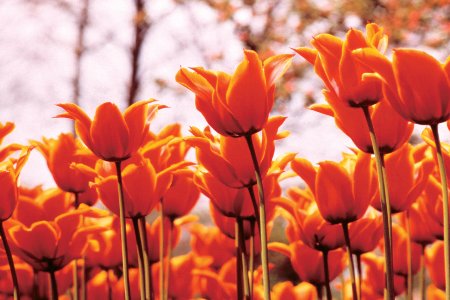
Totally Tulips
Issue 2 Nov / Dec 2003
Understandably, the prominence of tulips within Islamic culture may seem strange to us at first. The cultivation and image of the tulip has become inextricably linked with a stereotypical picture-postcard Holland of dykes, clogs and windmills. It is certainly true that Holland is nowadays the centre of the tulip world, and has been since the so-called ‘Tulipomania’ of the 17th Century. Holland now accounts for roughly 80% of the global market, but, as Jonathon Peacock finds out, it cannot claim to be the birthplace of the plant itself. The roots of our fascination with tulips, as well as the origins of the plant itself, lie a long way further back in time as well as a lot further East.
Indeed, the name tulip itself derives from the similarity in appearance to the turban, or dulban worn in those cultures where Westerners first encountered the flower. The original birthplace of the modern tulip lies within the mountainous area of Central Asia between China, Tibet and Afghanistan.Turks of the Ottoman Empire, which once included this region imported the plant at least 600 years before it became the height of Dutch horticultural fashion. In the Arabic script used by the Ottomans, the word given to this flower, lale, was similar to ‘Allah’ for the flower to become holy by association. The Qur’an also refers to Paradise as a luxurious Garden.
The ability of the tulip to flourish beautifully in harsh environments further encouraged the Turks to see them as an earthly promise of God’s bounty. The tulip’s popularity made it into a widely used motif in the decorative arts, painting, mosaics, tapestries, stained glass; so prevalent was the tulip in these fields that historians have given the name ‘The Tulip Age’ to the cultural and artistic renaissance of Ottoman Turkey in the early 18th century. Some scholars have seen further symbolic use of the tulip in Persian poetry, variously representing the Divine Fire and the Burning Bush.By the beginning of the 17th century, interest in tulips had begun to spread to Holland initially through Ghislain de Busbecq, the Austro-Hungarian Empire’s Ambassador in Turkey. He introduced the tulip to his friend Carolus Clusius, who introduced the tulip to Holland whilst chief botanist at the University of Leiden.
In Europe at this time gardens were still largely restricted to the practical uses of growing food and medicinal plants, and the appeal of botanical beauty for its own sake soon caught the popular imagination. As demand began to outstrip supply, the prices for the newest and rarest strains began to grow astronomically, changing hands for the equivalent of thousands of pounds, until the excessive speculation in the tulip market brought the Dutch economy to the brink of collapse.
Getting started with growing your own tulips
Within the tulip family, there is a wide selection of different strains and varieties to choose from, giving a diverse palette of colour and shape of blooms. Below are some generic tips and hints to help you get started, as well as a quick guide to some of the more commonly planted varieties.
Most tulip bulbs should be planted in late autumn and no later than November although some hardier varieties can be planted throughout the midwinter.
The soil should be lightweight and loose, low draining, sandy, rich with nutrients laid 12 inches below ground and eight inches above ground.
The tulips should be planted about 10cm deep and the same distance apart depending on the effect you wish to create (they look nice if grown together in fairly tight clusters, accentuating the bright warm colours of many varieties).
Ideally they need fairly alkaline soil – if you live in an area with acidic soil, you will need to add ground limestone for best results.
Make sure to water the bulbs when the buds begin to rise, this will lead to larger blooms and taller stems, but generally they flourish in dry, sunny conditions.
You can ensure a constant show of colour by planting various strains of bulb that flower at different times throughout the spring and summermonths
Early flowering varieties include Prinses Irene (a dark orange bloom with burgundy markings), Yokohama (bright yellow flower), Purissima (white), Oranje Nassau (orange and cherry red), Peach Blossom(pink and white).
Some later flowerers are Don Quichotte (grey-green), Maytime (crimson), Queen of Night (maroon), Dillenburg (flecked gold), Cordell Hull (dark red on white) and Mrs John T Scheepers (canary yellow)
When the flowers begin to wither, the dead flower heads should be cut off before they turn to seed to ensure a healthy plant the following year.
Rather than trimming or tying off the dying leaves however, let the stems turn brown and die off naturally, or trim the leaves only when they are already dead.
Leave the fallen foliage where it falls to the base of the plant; this will provide nourishment for the bulb for next year’s flowers.
When the flowers have fallen and while the soil absorbs these nutrients, you may wish to remove the bulbs and store them to replant in autumn. This will reduce the risk of your bulbs falling victim to slug attacks (slugs being particularly keen on tulips), or some of the fungal infections to which they are prone, such as Grey bulb rot or Tulip fire.
Store your bulbs in a warm dry place until the planting season comes round again
They can be grown in pots but will need regular watering and also need to be planted in specially formulated potting mix rather than plain earth to ensure successful nourishment. Also, some of the larger blossoming bulbs will require a deeper and wider container than others
Photos by: Netherlands
Flowerbulb Information Centre, 58 Jermyn Street London SW1Y 6LX
Tel: 020 7915 4777
Fax: 020 7915 4778
www.bulb.com
Also from Keukenhof,
www. keukenhof.com
Bookmark this |
|
Add to DIGG |
|
Add to del.icio.us |
|
Stumble this |
|
Share on Facebook |
|
Share this |
|
Send to a Friend |
|
Link to this |
|
Printer Friendly |
|
Print in plain text |
|


Comments
0 Comments